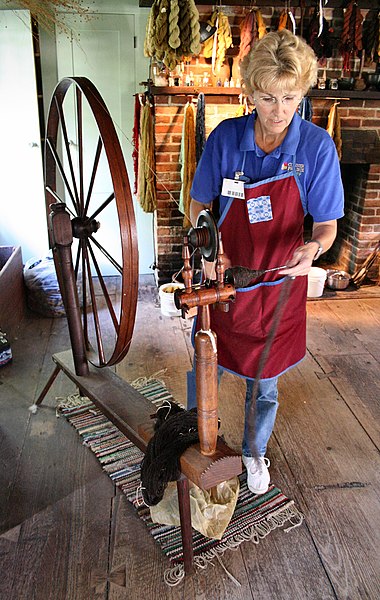I can imagine all sorts of activities that might take place during Colonial American celebrations—perhaps games or speeches.
But spinning on a spinning wheel?
Much to my surprise, the skill of spinning wool and flax was much celebrated, as described in Shirley Glubok’s
“Home and Child Life in Colonial Days.” And, at least on one occasion, was on display for all to admire:
“At the fourth anniversary in 1749 of the ‘Boston Society for promoting Industry and Frugality,’ 300 ‘young spinsters’ spun on their wheels on Boston Common. And a pretty sight it must have been: the fair young girls in the quaint and pretty dress of the times, spinning on the green grass under the great trees.”
If you have recovered by now from the image of this unexpected and spectacular exhibition, you may now marvel at the term “young spinster.” In
Colonial America, a spinster was a word attributed to a woman, whether young or old. It, of course, implied that only women did this particular art of turning raw flax or wool into the useable strands that were woven into cloth.
The history behind the production of flax in America is fascinating.
When the colonies were young, they needed a way to clothe the growing numbers of people. Animal skins only went so far.
So a mere 20 years after the
Mayflower found refuge at
Plymouth, the Court of Massachusetts passed a law for colonists to grow flax. This is the plant that, after many months of growing and processing, can be spun into linen—the material used for much of their clothing. It was determined which colonists were already adept at growing the crop and using a spinning wheel, and it was ordered that both girls and boys be taught the art of spinning. Classes were started so the children could learn the skill.
Flax was so important to these early settlers that a bounty was offered to encourage the growing, spinning and weaving of the plants. Families were actually required to spin a certain number of pounds of flax per year or be fined!
The fields of flax were a lovely display when in bloom, adorned with small blue flowers (see photo).
Months of arduous labor went into preparing the flax plants just so they could be readied for the spinning wheel. The long process was back-breaking, starting in the spring with planting the seed (thrown the same way you would toss grass seed) and weeding the tender plants, which was done barefoot by women and children. If thistles were in the field, they had to wear 4 layers of woolen stockings to protect their legs.
By July, flax was ready to be man-handled, pulled out by the roots, laid out to dry, combed for seeds, and the seeds collected for the next year. Then the heavy work began: stacking, washing, more drying, braking, hetcheling—terms we rarely use anymore.
A hetchel tool is very intimidating to view with its sixty-or-so long, sharp, iron spikes protruding from a heavy board. It is so frightening to look at that I used this flax tool as a weapon between enemies in my first novel,
“The Road to Deer Run.” The hetchel was not a tool one wanted to trip over in the dark!
But over time, growing flax lessened in importance in the colonies. The process took over a year from the time of its planting to being useable as linen ready to be sewn. Flax could also be difficult on the land.
“Growing flax was very hard on the soil so farmers eventually started raising more sheep, for their wool and for meat, plus they could live off of pretty marginal land,” said Dennis Picard, historian at
Storrowton Village Museum in
West Springfield, Massachusetts.
Colonists began blending the fibers of linen and wool, producing the cloth known as “linsey-woolsey.”
The men were not without responsibility in the production of clothing, however. The looms used to weave the yarn into cloth were heavy and difficult to use. While women certainly did do weaving, men often did this cumbersome task as well.
Of course, once the cloth was produced, then came the arduous task of hand-sewing this material into clothing for the entire family.
While today we casually add to our wardrobe by a trip to the mall, the early Americans must have highly valued each and every shirt or gown as precious—evidence of the skilled labor that invested months of hard work into its production. Pieces that were homespun treasures, indeed.
Photos of spinning wheel, loom, and linen garments taken by the author at Storrowton Village Museum, West Springfield, MA.














